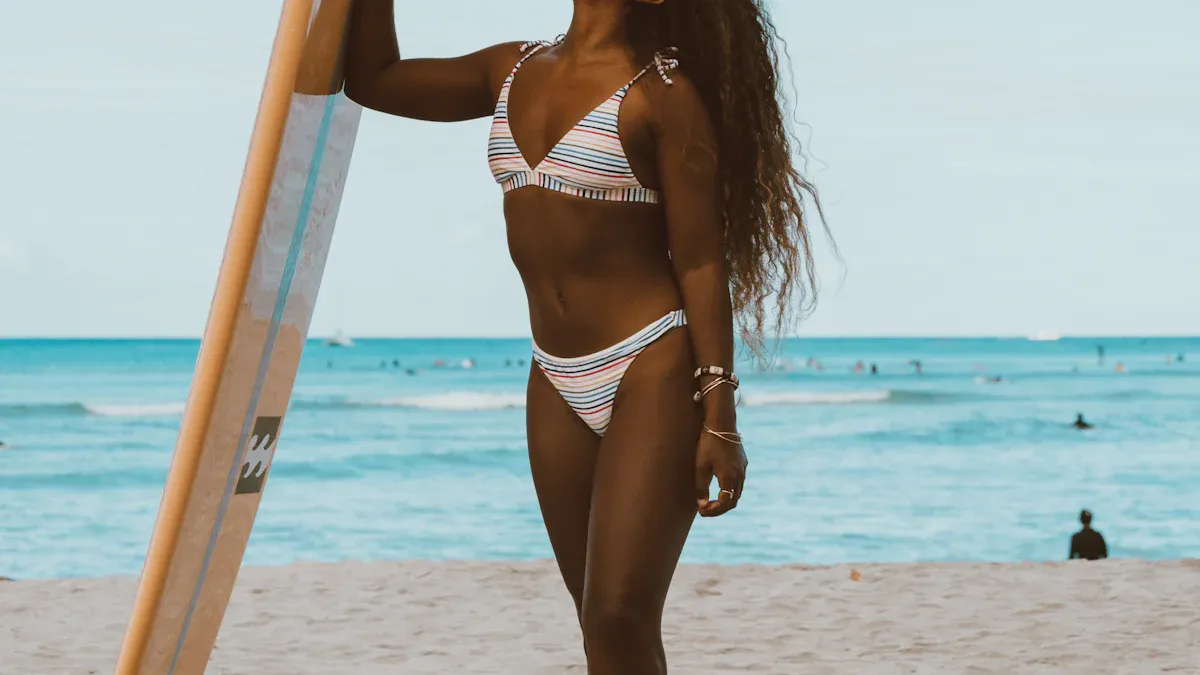This guide outlines a neutral, standards-based workflow for testing new swimwear designs with micro-orders (≈50 pcs MOQ), including supplier due diligence, laboratory methods, and post-launch KPIs for scale decisions.
Key Takeaways
50 pcs MOQ enables controlled product validation with limited capital exposure and reduced excess inventory risk.
Standards-driven QC (ASTM, AATCC, ISO, OEKO-TEX) ensures durability under UV, chlorine, and salt exposure—critical for swimwear performance.
Rapid feedback loops from limited releases accelerate pattern and materials refinement prior to bulk commitments.
Supplier due diligence and transparent BOMs reduce defects and lead-time variance, improving on-time delivery (OTD) and re-order reliability.
Decision with KPIs: inventory turnover, return rate, and conversion rate guide when to scale, pause, or iterate.
Why Choose a 50 pcs MOQ for Swimwear Testing
Small-batch orders let brands validate fit, construction, and colorfastness before large commitments. This approach prioritizes learning velocity and cash discipline over volume.
Benefits of Small-Batch Swimwear Orders
Faster reaction to demand signals and qualitative feedback from early adopters.
Closer process control and traceability per size/SKU for defect analysis.
Lower risk when trialing new prints, fabrics, or trims compared with high MOQs.
Applicability for both emerging and established labels to pilot micro-collections.
Lower Risk and Capital Control
Evidence-backed Practice | Why It Matters |
|---|---|
Phased commitments (samples → pilot run → scale) | Aligns cash outlay with validated demand; reduces unsold stock exposure. |
Specialized suppliers supporting low MOQ | Maintains quality gates without forcing large buys; enables faster iteration. |
Data-led go/no-go criteria | Objective thresholds for reorder prevent bias from anecdotal feedback. |
Fast Feedback on New Designs
Digital printing and flexible cut-and-sew capacity support rapid prototyping. Pair limited releases with structured surveys and return-reason coding to identify the highest-impact fixes (e.g., strap recovery, leg opening tension, print durability).
Swimwear Testing: Step-by-Step Process

Small-batch testing workflow.
Design Preparation and Fabric Testing
Target a blend of 80–90% base fiber + 10–20% elastane for stretch, print definition, and recovery. Validate performance using recognized lab methods before committing to bulk:
Colorfastness & Chlorine/Salt: AATCC TM162 (chlorine), ISO 105-E02 / AATCC 106 (salt), AATCC 61 (laundering).
UV Protection: AATCC TM183 and UV Standard 801 (test when wet and stretched).
Mechanical Strength: ASTM D5034 (grab tensile), ASTM D4964 (elastic behavior), ASTM D1683 (seam strength).
Comfort & Drying: ASTM D737 (air permeability), wicking/evaporation as applicable.
Chemical Safety: OEKO-TEX® Standard 100; regional compliance such as REACH (EU) and CPSIA (US) for restricted substances.
Tip: Record ΔE tolerances for prints and solids; specify target recovery percentages for straps and waistbands in the tech pack.
Finding Quality Suppliers for a 50 pcs MOQ
Select manufacturers with demonstrable experience in small-batch swimwear and transparent quality systems. Request the last three sample or inspection reports and confirm corrective actions closed on time.
Dimension | Metric | Weight |
|---|---|---|
Quality Assurance | Defect %, ΔE, seam strength (ASTM D1683) | 30% |
Cost Structure | BOM clarity, yield, transparency on CM & MOQ ladders | 20% |
Delivery & Capacity | OTD %, variance, surge handling | 20% |
Ethics & Sustainability | Certifications (ISO 9001, BSCI/SMETA), recycled content | 15% |
Collaboration & Comms | SLA cadence, change logs, sample lead time | 15% |
Due-diligence checklist: verify ISO 9001 certificate status, request OEKO-TEX® claims letters, review REACH/CPSIA lab reports for current season fabrics, and confirm bulk QA plan (AQL level, sampling size).
Placing a Micro-Order
Criteria | Recommendations |
|---|---|
Supplier Certifications | Prefer ISO 9001 + BSCI/SMETA or equivalent social compliance audit. |
Quality Documentation | Confirm REACH/CPSIA scope, RSL/MRSL adherence, and colorfastness test methods. |
Capacity Planning | Match order size to line availability; require firm lead time windows. |
Reliability Metrics | Target ≥95% OTD; track first-pass yield by style/size. |
Customization Scope | Pattern grading, fabric sourcing, print management, and branding components. |
Quality Verification | Pre-production, in-line, and final inspections (with acceptance criteria). |
Sample Policies | Paid samples with credit offset against bulk PO when approved. |
Lead Times | Typical bulk: 30–45 days post sample approval; confirm seasonality caveats. |
Sample Review for Quality and Durability
Quality Control Measure | Description |
|---|---|
Pre-Production Inspections | Verify fabric, trims, shade bands, and defects before cutting. |
In-Line Checks | Monitor pattern alignment, stitch density, and elastic recovery. |
Final Inspections | Assess fit, seam strength, pilling, and packaging; include wash/soak tests. |
Limited Release and Structured Feedback
Run a limited drop with a defined sample size. Capture feedback via short surveys and returns coding. Convert qualitative notes into change requests (CRs) for the next iteration, then re-test high-risk points (e.g., print bleed, strap elongation).
Maximizing Results: Iterate, Measure, Decide

Iterate based on structured feedback and KPI thresholds.
From Feedback to Design Changes
Translate feedback into measurable specifications: adjust pattern grading, revise elastane percentage, update stitch specs, or change lining GSM. Validate changes with the same lab methods to ensure comparability across iterations.
When to Scale: KPI Benchmarks
KPI | Definition | Typical Range | How to Improve |
|---|---|---|---|
Inventory Turnover | How often stock sells/replenishes in a period | ~4–10x/year (category-dependent) | Improve demand planning, shorten cycle time, refine assortment. |
Return Rate | Share of items returned | ~10–20% | Clarify size charts, introduce virtual try-on, analyze top return codes. |
Conversion Rate | Visitors who purchase | ~2–5% | Reduce checkout friction, use personalized merchandising, optimize PDP content. |
Composite Case Study (anonymized): A niche label piloted five micro-collections at 50 pcs each. After two fit/print iterations, returns fell from high-teens to single digits, and re-order volume rose >30%. The brand proceeded to a 300–500 pcs scale-up with stable OTD.
Common Pitfalls—and How to Avoid Them
Supplier Reliability
Late deliveries and shade variances often stem from unclear SLAs and insufficient inline checks. Mitigation: weekly production updates, photo checkpoints, and pre-shipment AQL inspections.
Quality & Durability
Inadequate chlorine/UV testing leads to early fading and fiber degradation.
Weak seams or poor elastic recovery cause fit failures after wear.
Unverified chemical safety risks non-compliance in target markets.
Misjudging Demand
Over-ordering leads to tied-up cash; under-ordering sacrifices sell-through. Use limited drops, waitlists, and demand signals before committing to larger POs.
MOQ Range | Baseline Timelines | Notes |
|---|---|---|
50–500 | ~4–8 weeks | Complexity and seasonality can extend lead time. |
Pilot MOQs | N/A | Validate demand before scaling; freeze prints/grades after sign-off. |
Quality control reduces returns and strengthens repeat purchase intent.
Durable construction builds trust and protects margins.
Iterative feedback loops de-risk innovation cycles.
FAQ
How do I start with a micro-order for swimwear?
Shortlist suppliers that accept 50 pcs MOQs, request paid samples, run fit and durability tests using recognized methods (AATCC/ASTM), then proceed to a limited pilot before bulk.
Can I use digital printing for small swimwear batches?
Yes. It supports rapid iteration and complex artwork. Specify color targets (ΔE), fabric pre-treatment, and washfastness tests to ensure durability.
What defines a fully custom product in swimwear?
Full control over fabric blend, pattern grading, print/solid choices, labels/hardware, and packaging. Document all specs in a complete tech pack.
How does customer feedback help when testing a market?
Quantify insights via surveys and size/fit analytics; map return reasons to engineering fixes (e.g., rise height, elastic modulus) for the next iteration.
Is it possible to order custom swimwear with own artwork at 50 pcs?
Common among specialized factories. Align on print file specs (resolution, repeat), color profiles, and strike-off approvals prior to bulk.
References & Standards
ASTM D1683 (Seam Strength); ASTM D5034 (Grab Tensile); ASTM D4964 (Stretch Properties); ASTM D737 (Air Permeability) — ASTM International
AATCC TM162 (Chlorine), AATCC 106/ISO 105-E02 (Sea Water), AATCC 61 (Laundering), AATCC TM183 (UPF) — AATCC
UV Standard 801 — UV Standard 801
OEKO-TEX® Standard 100 — OEKO-TEX
REACH (EU), CPSIA (US) — official regulatory portals
Industry outlook and KPIs — category benchmarks commonly cited across reputable market research and apparel operations literature (non-promotional, method-agnostic summaries)
Note: KPI ranges are indicative and vary by assortment, channel mix, and seasonality. Always compare against your own trailing data.
